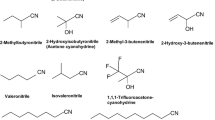Abstract
A broad range of epoxyalkanes was converted into the corresponding ketones by cell extracts of Xanthobacter Py2. Both 1,2- and 2,3-epoxyalkanes were degraded and in addition, the degradation of 2,3-epoxyalkanes in all cases was highly enantioselective. Conversion of a deuterium-labelled substrate indicated that the ketone product was probably formed indirectly via an hydroxy intermediate. Degradation of epoxyalkanes by Xanthobacter Py2 was dependent on both NAD and another, not yet identified, cofactor that was present in the low-molecular-mass fraction (LMF) of propene-grown cells. It is proposed that the LMF was involved in a reductive reaction step since it could be replaced by dithiothreitol (DTT) and various other dithiol compounds. Epoxyalkane-degrading activity was inhibited by the sulphhydryl blocking reagent N-ethylmaleimide (NEM). Inhibition by NEM and stimulation by LMF, DTT and other dithiols was effective only in the simultaneous presence of NAD.
Similar content being viewed by others
References
Bont JAM de (1993) Bioformation of optically pure epoxides. Tetrahedron: Asymmetry 4:1331–1340
Bont JAM de, Harder W (1978) Metabolism of ethylene by Mycobacterium E20. FEMS Microbiol Lett 3:89–93
Bont JAM de, Dijken JP van, Ginkel CG van (1982) The metabolism of 1,2-propanediol by the propylene oxide utilizing bacterium Nocardia A60. Biochim Biophys Acta 714:465–470
Bradford MM (1976) A rapid and sensitive method for the quantitation of microgram quantities of protein utilizing the principle of protein-dye binding. Anal Biochem 72:248–254
Carter SF, Leak DJ (1993) The isolation and genetic construction of cyclic epoxide degrading bacteria. In: Griengl H, Steiner W, Faber K, Preisz A (eds) Abstracts of the European Symposium on Biocatalysis, Graz, Austria, 12–17 Sept 1993, Federal Ministry for Science and Research, Vienna, p P-50
Cleland WW (1964) Dithiothreitol, a new protective reagent for SH groups. Biochemistry 3:480–482
Dobson NA, Eglinton G, Krishnamurti M, Raphael RA, Willis RG (1961) Selective catalytic hydrogenation of acetylenes. Tetrahedron 16:16–24
Fasco MJ, Preusch PC, Hildebrandt E, Suttie JW (1983) Formation of hydroxyvitamin K by vitamin K epoxide reductase of warfarin-resistant rats. J Biol Chem 258:4372–4380
Ginkel CG van, Bont JAM de (1986) Isolation and characterization of alkene-utilizing Xanthobacter spp. Arch Microbiol 145:403–407
Ginkel CG van, Welten HGJ, Bont JAM de (1986) Epoxidation of alkenes by alkene-grown Xanthobacter spp. Appl Microbiol Biotechnol 24:334–337
Hartmans S, Smits JP, Werf MJ van der, Volkering F, Bont JAM de (1989) Metabolism of styrene oxide and 2-phenylethanol in the styrene-degrading Xanthobacter strain 124X. Appl Environ Microbiol 55:2850–2855
Hechtberger P, Wirnsberger G, Mischitz M, Klempier N, Faber K (1993) Asymmetric hydrolysis of epoxides using an immobilized enzyme preparation from Rhodococcus sp. Tetrahedron: Asymmetry 4:1161–1164
Jacobs MHJ, Wijngaard AJ van den, Pentenga M, Janssen DB (1991) Characterization of the epoxide hydrolase from an epichlorohydrin-degrading Pseudomonas sp. Eur J Biochem 202:1217–1222
Kasai N, Tsujimura K, Unoura K, Suzuki T (1990) Degradation of 2,3-dichloro-1-propanol by a Pseudomonas sp. Agric Biol Chem 54:3185–3190
Leak DJ, Aikens PJ, Seyed-Mahmoudian M (1992) The microbial production of epoxides. TIBTECH 10:256–261
Lee JJ, Fasco MJ (1984) Metabolism of vitamin K and vitamin K 2,3-epoxidevia interaction with a common disulfide. Biochemistry 23:2246–2252
Liptay-Reuter I, Dose K, Guenthner T, Wörner W, Oesch F (1985) Vitamin K epoxide reductase activity in the metabolism of epoxides. Biochem Pharmacol 34:2617–2620
Ophem PW van, Beeumen J van, Duine JA (1992) NAD-linked, factor-dependent formaldehyde dehydrogenase or trimeric, zinc-containing, long-chain alcohol dehydrogenase from Amycolatopsis methanolica. Eur J Biochem 206:511–518
Pasto DJ, Cumbo CC (1965) An improved methodfor the preparation of volatile epoxides. J Org Chem 30:1271–1272
Pedragosa-Moreau S, Archelas A, Furstoss R (1993) Enantiocomplementary epoxide hydrolyses as a preparative access to both enantiomers of styrene oxide. J Org Chem 58:5533–5536
Schurig V, Bürkle W (1982) Extending the scope of enantiomer resolution by complexation gas chromatography. J Am Chem Soc 104:7573–7580
Silverman RB (1981) Chemical model studies for the mechanism of vitamin K epoxide reductase. J Am Chem Soc 103:5939–5941
Steckbeck SR, Nelson JA, Spencer TA (1982) Enzymic reduction of an epoxide to an alcohol. J Am Chem Soc 104:893–895
Torchinskii YuM (1974) The role of SH groups in enzymes. In: Torchinskii YuM (ed) Sulfhydryl and disulfide groups of proteins. Consultants Bureau, London, pp 185–198
Weijers CAGM, Haan A de, Bont JAM de (1988a) Microbial production and metabolism of epoxides. Microbiol Sci 5:156–159
Weijers CAGM, Haan A de, Bont JAM de (1988b) Chiral resolution of 2,3-epoxyalkanes by Xanthobacter Py2. Appl Microbiol Biotechnol 27:337–340
Whitlon DS, Sadowski JA, Suttie JW (1978) Mechanism of coumarin action: significance of vitamin K epoxide reductase inhibition. Biochemistry 17:1371–1377
Author information
Authors and Affiliations
Rights and permissions
About this article
Cite this article
Weijers, C.A.G.M., Jongejan, H., Franssen, M.C.R. et al. Dithiol- and NAD-dependent degradation of epoxyalkanes by Xanthobacter Py2. Appl Microbiol Biotechnol 42, 775–781 (1995). https://doi.org/10.1007/BF00171961
Received:
Revised:
Accepted:
Issue Date:
DOI: https://doi.org/10.1007/BF00171961




